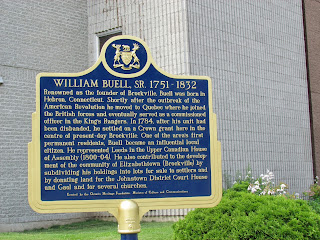One often hears the name Billa Flint in Belleville/Hastings County, associated with some philanthropy or business venture, but the book enabled me to finally connect all the industrious dots in this nation-builder's story. I'm hoping to do a post soon with local links.
 |
| Robertson house (1852). Flint Street to the left |
But there is an intriguing connection with Billa Flint in Brockville, and a walkabout in the oldest section of the city gave me an opportunity to explore his origins. Before he tired of his father's irascible drunken ways, and set out to seek his fortune in Belleville. Which he did.
But back to Billa Flint Sr. In 2014 I met Curt Wheeler, when we both joined up with Tom Cruickshank's tour group visiting the restored homes (and church) of John and Diane Brisley in Prince Edward County.
(I've blogged about this dedicated couple on occasion, and shared their story in the spring 2014 issue of County and Quinte Living.)
 |
| Robert Shepherd Grist Mill 1853 |
 |
| Isaac Beecher House (c.1815/c.1840) |
Curt Wheeler hosts a FB group called Early Ontario Homes. Last time I looked there were photos of the stone house and barn of Billa Flint Sr., posted sometime in April 2014.

I was intrigued to read La Barge's account of the Junior Flint's early life in Brockville, where his obstreperous father had moved the family and the family business after the end of the War of 1812.
Brockville on the St. Lawrence was a booming town, although fractious. Sounds like the elder Flint's contemporaries might have been as contrary as he was. One of the biggest controversies in which town-folk were engaged was choosing a name for the place! Took them twenty years!
Names that were floated were Buell's Bay, or Williamstown (one of the early movers was Willliam Buell, who still boasts a street named in his honour.)
Charles Jones offered Charlestown. So much bickering took place that some wag coined the name 'Snarlington.' Fortunately, from the ashes of the war a hero emerged, and it was easy for all to adopt the name Brockville.
 |
| Robert Shepherd House c.1835 |
 |
| John Lafayette House c.1845 |
 |
| John C. Potter House c.1833 |
A link to it can be found at blogger Doug Grant's 'Brockville History Album', a great site. It's William Buell's 1816 map of the city. On it, you can see the properties accumulated by Billa Flint Sr. And William Buell. And many of the old names still associated with places I visited, heritage walking tour guide in hand. (Around the Town, published by the Brockville Museum.)
 |
| Chaffey/McMullen House c.1834 |
 |
| Thomas Cunningham Store 1846 |
 |
| George Malloch House c.1840 |
The map shows a small piece of property under the name of Billa Flint. Today Flint Street runs beside it still, with a great hulking high-rise above it. He was an ambitious man; he'd likely be pleased.
This former commercial/industrial/residential area (no zoning obsessiveness in those get-ahead days) is calling me back already. There are still some old doors inviting me inside, a few stops further along the walking tour of Brockville on the St. Lawrence.



Billa Sr died in 1852 with over 15,000 acres and properties in Brockville, Morristown, NY and Cleveland, Ohio amongst other places. He set Billa Jr up in Belleville and bailed him out of bankruptcy on more than one occasion. Billa Sr's will was contested by Jr to get more money! He was only left $100 since as Sr said, he had given him the equivalent of over $100,000 in his life. He ended up with 1/6 of Sr's estate which was valued at over $550,000 in 1852. Sr I believe was the real businessman and his estate flowed into the pockets of the future prominent familes in Brockville, including the Comstock family and the Cossitt's.
ReplyDelete